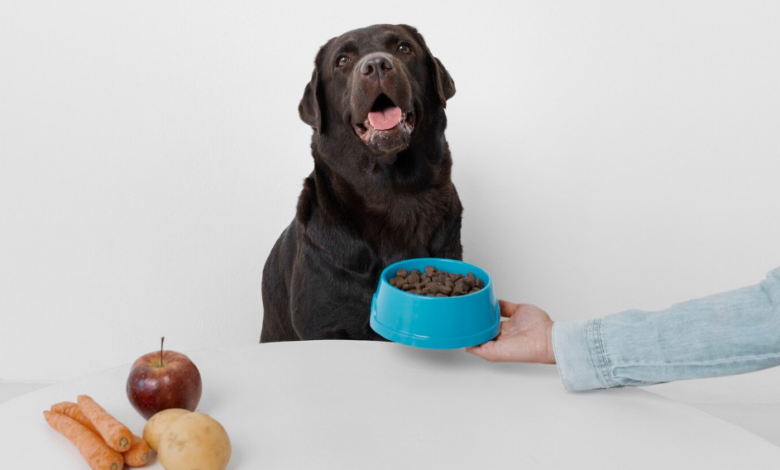The Rise of Premium Dog Food: Why More Pet Owners Are Switching

Understanding the Shift Towards Premium Dog Food
Evolving Pet Parent Mindset
There’s been a real change in how people see their pets. They’re not just animals anymore; they’re family. This shift is a big reason why more and more pet owners are willing to spend extra on things like premium dog food. People want the best for their furry friends, just like they want the best for their kids. It’s about providing a good life, filled with love, care, and, of course, good food. You can see this reflected in the growing pet market near me and everywhere else.
- Pets are seen as family members.
- Owners want to provide the best possible care.
- Willingness to spend more on quality products.
This change in mindset is driving the demand for higher-quality pet products and services. People are more informed and proactive about their pet’s well-being.
Increased Awareness of Pet Nutrition
We’re all getting smarter about what we eat, and that includes what our dogs eat. There’s so much more information out there now about pet nutrition. People are reading labels, researching ingredients, and understanding the impact of diet on their dog’s health. It’s not just about filling a bowl anymore; it’s about providing a balanced and nutritious meal. This increased awareness is pushing people towards premium dog food options.
- More information available about pet nutrition.
- Owners are reading labels and researching ingredients.
- Understanding the impact of diet on health.
The Humanization of Pets
This is a big one. We treat our pets more and more like humans. They sleep in our beds, they get birthday presents, and yes, they eat better food. This “humanization” trend is a major driver in the premium dog food market. If we’re eating organic and healthy, why shouldn’t our dogs? It’s all part of treating them like members of the family. The pet market near me is booming with options that cater to this trend.
- Pets are treated more like humans.
- Owners want to provide similar quality of life.
- Demand for human-grade ingredients in pet food.
| Feature | Standard Dog Food | Premium Dog Food |
| Ingredient Quality | Lower | Higher |
| Nutritional Value | Lower | Higher |
| Price | Lower | Higher |
Key Benefits of Choosing Premium Dog Food
Superior Ingredient Quality
When you switch to [
Decoding Premium Dog Food Labels
Identifying High-Quality Protein Sources
Okay, so you’re standing in the pet store, staring at a wall of dog food bags. It’s overwhelming, right? The first thing to look for when choosing premium dog food is the protein source. You want to see real meat listed as the first ingredient – chicken, beef, lamb, or fish. Avoid anything vague like “meat by-products” or “animal digest.” Those are usually low-quality and can come from questionable sources. Also, pay attention to the order of ingredients. The ingredients are listed in descending order by weight, so the first few ingredients make up the bulk of the food. If corn or wheat is listed before the protein, that’s a red flag.
The Importance of Whole Grains and Vegetables
Carbohydrates are important for energy, but not all carbs are created equal. Whole grains like brown rice, quinoa, and oats are much better than refined grains like white rice or corn. Vegetables like sweet potatoes, carrots, and spinach provide essential vitamins and minerals. These ingredients should be clearly listed on the label. Fiber is also important for digestion, so look for ingredients like beet pulp or pumpkin. The amount of fiber can vary, and some dogs do better with more or less. It’s something to keep in mind as you monitor your dog’s response to the food.
Avoiding Artificial Additives and Fillers
This is where things get tricky. You want to avoid artificial colors, flavors, and preservatives. These additives offer no nutritional value and can even be harmful to your dog. Common artificial additives to watch out for include BHA, BHT, ethoxyquin, and artificial colors like Red 40 or Yellow 5. Fillers are ingredients that add bulk to the food without providing any nutritional value. Corn, wheat, and soy are common fillers. While some dogs can tolerate these ingredients, they’re generally not the best choice for optimal health. If you’re looking for premium dog food, you’ll want to avoid these as much as possible. You might even want to check out the pet market near me to see if there are any local brands that focus on natural ingredients.
It’s important to remember that every dog is different. What works for one dog may not work for another. Pay attention to your dog’s individual needs and preferences when choosing a food. If you’re unsure, talk to your veterinarian for personalized advice.
The Impact of Diet on Canine Well-being
Boosting Immune System Function
What your dog eats really matters for their immune system. Think of it like this: good food helps them fight off sickness. Premium dog food is often packed with vitamins and antioxidants that give their immune system a real boost. It’s not just about avoiding illness; it’s about keeping them healthy and active.
- Vitamin E
- Vitamin C
- Omega-3 Fatty Acids
A strong immune system means fewer vet visits and a happier, healthier dog. It’s an investment in their long-term well-being.
Maintaining Optimal Weight and Energy Levels
Keeping your dog at a healthy weight is super important. Too heavy, and they’re at risk for all sorts of problems. Too skinny, and they might not have the energy they need. Premium dog food can help with this because it’s usually got a good balance of protein, fats, and carbs. It’s all about finding the right food that keeps them feeling good and full of energy.
| Food Type | Calories per Cup | Protein (%) | Fat (%) |
| Standard Kibble | 400 | 22 | 12 |
| Premium Dog Food | 380 | 30 | 18 |
| Weight Management | 350 | 25 | 10 |
Addressing Specific Health Concerns with Premium Dog Food
Sometimes, dogs have specific health problems that can be helped with the right food. For example, if your dog has allergies, a limited-ingredient diet might be the way to go. Or, if they have joint problems, food with glucosamine and chondroitin could help. It’s always a good idea to talk to your vet about what’s best for your dog’s individual needs. You can even search for a “pet market near me” to find specialized options. Premium dog food isn’t just a trend; it’s a way to give your dog the best possible care. It’s about understanding their needs and making informed choices. It’s about more than just filling their bowl; it’s about fueling their life.
Navigating the Premium Dog Food Market
Finding the right premium dog food can feel overwhelming. There are so many brands and types out there! It’s not as simple as just grabbing the first bag you see. You need to do a little research to make sure you’re getting the best food for your furry friend.
Researching Reputable Brands
Start by looking into different brands. Not all premium dog food is created equal. Some brands have been around for a long time and have a solid reputation for quality and safety. Others might be newer to the pet market near me, but that doesn’t automatically make them bad. Read reviews, check out their websites, and see if they have any certifications or endorsements from veterinary nutritionists. Look for brands that are transparent about their ingredients and manufacturing processes. A good brand will be open about where their ingredients come from and how they make their food.
- Check online reviews from other pet owners.
- Look for certifications from organizations like the Association of American Feed Control Officials (AAFCO).
- Visit the brand’s website to learn about their ingredients and manufacturing processes.
Considering Breed and Age-Specific Formulas
Just like people, dogs have different nutritional needs depending on their breed and age. A tiny Chihuahua puppy isn’t going to need the same food as a giant Great Dane senior. Many premium dog food brands offer formulas specifically designed for different breeds and life stages. These formulas take into account things like calorie needs, joint support, and digestive health. For example, large breed puppy formulas often have controlled calcium levels to help prevent bone and joint problems. Senior formulas might have added glucosamine and chondroitin to support aging joints. Pay attention to these details when choosing a food.
Understanding Price Versus Value in Premium Dog Food
Premium dog food is definitely more expensive than your average kibble. But it’s important to think about the long-term value. While the initial cost might be higher, the benefits of better ingredients and improved health can save you money in the long run. You might have fewer vet visits, and your dog might live a longer, healthier life. Don’t just look at the price tag; look at the ingredients list and the nutritional content. A cheaper food might seem like a good deal, but if it’s full of fillers and artificial ingredients, it’s not really a bargain. Consider the serving size too. A higher-quality food might be more nutrient-dense, so you can feed your dog less of it.
It’s easy to get caught up in the price of premium dog food, but remember that you’re investing in your dog’s health and well-being. Think of it as preventative care. A good diet can help prevent health problems down the road, which can save you money and heartache in the long run.
Real Stories: Transformations with Premium Dog Food
Testimonials from Satisfied Pet Owners
It’s one thing to read about the benefits of premium dog food, but it’s another to hear it straight from pet owners who’ve seen the difference firsthand. We talked to several people who switched their dogs to better food, and the stories are pretty amazing.
- Sarah from Ohio noticed her older Labrador, Buddy, had more energy after just a few weeks on a new diet. He was playing fetch again like he used to when he was younger.
- Mark in California said his picky eater, a small terrier named Peanut, finally started eating regularly and stopped having digestive issues after switching to a grain-free option.
- Then there’s Emily from Texas, whose golden retriever, Goldie, had chronic skin allergies that cleared up almost completely after changing to a limited-ingredient premium dog food.
These are just a few examples of how a change in diet can really impact a dog’s life.
Veterinarian Perspectives on Nutritional Upgrades
Veterinarians are often the first to recommend a switch to premium dog food, and for good reason. They see the impact of diet on canine health every day. I spoke with Dr. Lee, a vet at a local clinic, and she emphasized the importance of quality ingredients. She said that many common health problems, like obesity and skin issues, can be directly linked to poor nutrition.
“We often see dogs come in with a range of problems that can be improved, or even resolved, with a better diet. It’s not just about filling them up; it’s about providing the nutrients they need to thrive. I always advise owners to look closely at the ingredient list and choose foods with real meat, whole grains, and vegetables.”
Dr. Ramirez, another vet I talked to, mentioned that she often recommends specific premium dog food brands based on a dog’s breed, age, and health conditions. She also pointed out that while premium food might cost more upfront, it can save money in the long run by reducing vet bills.
Before and After Health Improvements
Seeing is believing, right? Here are some specific examples of health improvements pet owners have observed after switching to premium dog food.
- Improved Digestion: Many dogs experience less gas, bloating, and diarrhea.
- Healthier Coat: A shinier, softer coat is a common sign of better nutrition.
- Increased Energy: Dogs often become more active and playful.
- Weight Management: Premium food can help dogs maintain a healthy weight.
Here’s a simple table showing some common improvements:
| Improvement | Before Premium Food | After Premium Food |
| Energy Levels | Low | High |
| Coat Condition | Dull | Shiny |
| Digestive Issues | Frequent | Rare |
| Weight Management | Overweight/Underweight | Healthy |
If you’re looking for premium dog food or a pet market near me, it’s worth doing some research and talking to your vet. The results can be truly life-changing for your furry friend. It’s not just about feeding them; it’s about nourishing them.
Making the Switch to Premium Dog Food
Gradual Transitioning Techniques
Switching your dog to a new food, especially a premium dog food, isn’t something you should do overnight. A sudden change can really upset their stomach and lead to digestive issues. Think of it like changing your own diet – you wouldn’t go from eating fast food every day to a strict salad-only diet without some serious consequences! The same applies to our furry friends.
Here’s a simple method for a smooth transition:
- Days 1-2: Mix 25% premium dog food with 75% of their old food.
- Days 3-4: Mix 50% premium dog food with 50% of their old food.
- Days 5-6: Mix 75% premium dog food with 25% of their old food.
- Day 7: 100% premium dog food.
This gradual approach allows your dog’s digestive system to adjust to the new ingredients and prevent any unpleasant side effects. Remember to monitor their stool consistency during the transition. If you notice any diarrhea or vomiting, slow down the process or consult your vet.
Monitoring Your Dog’s Response
Once you’ve fully transitioned your dog to premium dog food, it’s important to keep a close eye on them. Look for any changes in their behavior, appetite, energy levels, and stool. These observations will give you insights into how well they’re adapting to the new diet.
Here are some things to watch out for:
- Stool Quality: Healthy stool should be firm and well-formed. Diarrhea or constipation could indicate an issue.
- Appetite: A healthy appetite is a good sign. If your dog suddenly loses interest in food, it could be a concern.
- Energy Levels: Premium dog food should provide sustained energy. Notice if your dog seems more energetic or lethargic.
- Coat and Skin: A shiny coat and healthy skin are indicators of good nutrition. Look for improvements in these areas.
- Weight: Monitor your dog’s weight to ensure they’re maintaining a healthy body condition.
It’s a good idea to keep a journal or use a pet care app to track these observations. This will help you identify any patterns or potential problems early on. If you notice anything concerning, don’t hesitate to reach out to your veterinarian.
Consulting Your Veterinarian for Personalized Advice
Before making any significant changes to your dog’s diet, it’s always best to consult with your veterinarian. They can assess your dog’s individual needs and recommend the best premium dog food based on their breed, age, activity level, and any existing health conditions. Your vet can also help you determine the appropriate portion sizes and feeding schedule. They might also know about the best [
Conclusion
So, what’s the big takeaway here? It’s pretty clear that more and more dog owners are choosing better food for their furry friends. We’re talking about food with good stuff in it, not just fillers. People are seeing that what their dogs eat really does make a difference in how they act and feel. It’s not just a trend; it’s a real shift in how we think about our pets’ health. Giving your dog good food can mean fewer vet visits and a happier, more active dog. It just makes sense to give them the best we can.




